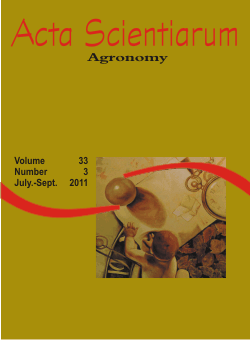<b>In vitro germination and disinfestation of sweet cactus (<em>Nopalea cochenillifera</em> (L.) Salm Dyck)</b> - doi: 10.4025/actasciagron.v33i3.6275
Keywords:
Cactaceae, forage, tissue culture
Abstract
This work aimed to promote in vitro seed germination and disinfestation of the sweet cactus. Seeds were submerged in alcohol at 70% for 1 min. and then treated with sodium hypochlorite solution at different concentrations: 0.0; 0.5; 1.0 and 1.5%. After this treatment, the seeds were washed four times in distillated, deionized and autoclaved water. Seeds were inoculated in MS medium with different concentrations of sucrose (0.0, 2.5, 5.0, 7.5 and 10.0 g L-1). The experimental design was completely randomized in a factorial experiment 4 x 5, with five replicates for treatments. Contamination, germination and seedling growth were evaluated. The results of the analysis of variance indicate that there were no significant interactions among factors. There was no significance for sucrose concentrations on contamination but these treatments showed significant differences for seed germination and seedling growth (p ≤ 0.01). At higher sucrose concentrations there was lower germination and smaller seedlings. There were significant differences between the treatments with sodium hypochlorite for all traits analysed (p ≤ 0.01). There was low contamination with the increase in sodium hypochlorite concentrations with higher germination percentage and taller seedlings.Downloads
Download data is not yet available.
Published
2011-04-11
How to Cite
Castro, J. P. de, Araújo, E. R., Rêgo, M. M. do, & Rêgo, E. R. do. (2011). <b>In vitro germination and disinfestation of sweet cactus (<em>Nopalea cochenillifera</em> (L.) Salm Dyck)</b> - doi: 10.4025/actasciagron.v33i3.6275. Acta Scientiarum. Agronomy, 33(3), 509-512. https://doi.org/10.4025/actasciagron.v33i3.6275
Issue
Section
Crop Production
DECLARATION OF ORIGINALITY AND COPYRIGHTS
I Declare that current article is original and has not been submitted for publication, in part or in whole, to any other national or international journal.
The copyrights belong exclusively to the authors. Published content is licensed under Creative Commons Attribution 4.0 (CC BY 4.0) guidelines, which allows sharing (copy and distribution of the material in any medium or format) and adaptation (remix, transform, and build upon the material) for any purpose, even commercially, under the terms of attribution.
2.0
2019CiteScore
60th percentile
Powered by 

2.0
2019CiteScore
60th percentile
Powered by 



















































